

#Macos big sur clean install update#
In theory, a clean update should be a perfect task to perform in Recovery mode, but in reality the limited choice of macOS installations may not match your plans.
#Macos big sur clean install install#
If you’re unsure whether anything important will survive migration or reinstallation, a clean install could have serious impact on your Mac, and you may be wiser simply to upgrade in the normal way. If an essential kernel extension isn’t migrated to your new system, you could find it almost impossible to install yourself. Security policy has changed substantially in recent years, and unsigned kernel extensions can’t readily be installed afresh, although they can still be grandfathered across in upgrades. One example is when you depend on old hardware such as an external RAID drive which is only supported by an old kernel extension. Sometimes, the migration itself can cause unexpected problems. Whether you migrate user accounts and apps from a copy or backup, or laboriously reinstall everything you need on your new system, there’s a chance that something important will get left out and cause problems. If you see this as a good opportunity to clean those up, and are prepared to spend the time doing so, you may find a clean install worth the extra effort. Those include your bulging Library folder which is bound to contain the remains of all sorts of apps long since removed. Where there can be benefits are in those system files, including Safari, which are stored not on the SSV, but on your writeable Data volume, and in the others there. So as far as the System volume is concerned, there’s nothing to be gained in a clean over a regular install. Every time that system is booted, its integrity is verified against Apple’s master Seal. That is first installed on the separate System volume, every file checked for integrity, the whole volume ‘sealed’ with a cryptographic hash, and then saved as an immutable snapshot.

This article asks what benefits there are to doing this with Monterey or Big Sur, and how you can do it.īig Sur and Monterey are different from all previous versions of macOS in that the great bulk of macOS is loaded and run from a Sealed System Volume (SSV). In the days when system and user files were all intermingled in the same volume, there were good arguments that the result was worth the extra effort, both in cleaning out the crud accumulated over the years, and in ensuring that we started with a perfect, mint copy of macOS. In the past, many of us took the opportunity when upgrading to a major new version of macOS to perform a clean install onto a freshly-formatted disk.


 0 kommentar(er)
0 kommentar(er)
